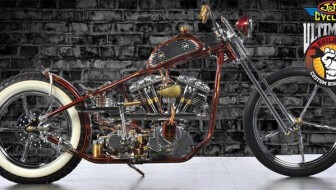The 2nd Annual AMD Invitational Custom Bike Show is held in Milwaukee on the Harley-Davidson Museum campus. It starts on Thursday, August 29, 2013 and runs through Sunday night on September 1, 2013.
Paul Anderson is bringing his 1946 Harley-Davidson 45 flathead called Once in Awhile. This is an outstanding bike that won the Ultimate Builder Retro MOD class in NOVI, MI and took a top 3 at the 2013 Ultimate Builder Championship in Indy. He was awarded the Cycle Source’s Editor’s Choice Award at Indy earlier this year.
Anderson’s Flathead Mil
A flathead engine (aka sidevalve engine (SV), flathead, or flatty)[1] is an internal combustion engine with valves placed in the engine block beside the piston, instead of in the cylinder head, as in an overhead valve engine. As the cylinder cross-section has the shape of an upside-down L, other names such as L-block or L-head are also common.

The Flathead
The sidevalve’s poppet valves are usually sited on one side of the cylinder(s). A recess in the cylinder head creates a corridor connecting the valves and the combustion chamber. The valve gear comprises a camshaft which operates the valves via simple tappets, without any further valvetrain paraphernalia (such as pushrods, rocker arms, overhead valves or overhead camshafts).
The flathead engine saw service in Harley-Davidson motorcycles beginning with the Model W’s flat-twin, produced from 1919 to 1923,[8] and continuing in 1924 with single-cylinder export-model 21 cubic inches (340 cc) and 30.5 cubic inches (500 cc) singles and continued in Servi-Cars until 1973. In the domestic U.S. market, the 45 cubic inches (740 cc) DL model (1929 to 1931) and its technical descendant, the RL model (1932 to 1936), started Harley’s side-valve tradition in the 45-cubic-inch displacement class. The DL and RL models featured a total-loss oiling system and were succeeded in 1937 by the WL 45, which had recirculating oil lubrication.

A flathead engine aka sidevalve engine (SV), flathead, or flatty
The WL went on to serve in World War II as the U.S. and Canadian Army’s primary two-wheeled mount and subsequently as a civilian middleweight through 1952. The engine continued virtually unchanged with various G-based designations in the three-wheeled “Servi-Car” until production ceased in 1973.











